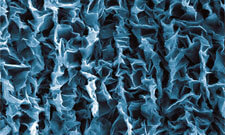Engineers from Duke University have succeeded in creating layers of carbon networks with a thickness of a single atom (graphene) in combination with polymers to create unique materials with a wide range of applications, including artificial muscles

Engineers from Duke University have succeeded in creating layers of carbon networks with a thickness of a single atom (graphene) in combination with polymers to create unique materials with a wide range of applications, including artificial muscles.
The network, known as graphene, is made up of pure carbon atoms and looks like the iron mesh of a chicken coop. Due to its unique optical, electronic and mechanical properties, graphene is used in electronic components, energy storage devices, composite materials and biomedical applications.
At the same time, it is very difficult to handle graphene since it tends to fold easily and therefore its properties can change, depending on the circumstances. Unfortunately, scientists have not been able to control the folding of large-scale graphene and properly exploit its unique properties. Duke University engineering professor Xuanhe Zhao likens the challenge of controlling graphene to the difference between folding a newspaper versus folding wet toilet paper.
"If you fold regular paper, it can then be flattened quite easily," explains the researcher. "In contrast, graphene is more like wet toilet paper. It is extremely thin and sticky and it is difficult to flatten it back after it has already been folded. We have developed a method to solve this problem and control the folding and flattening of graphene with large dimensions."
The Duke University engineers tied the graphene to a rubber band that had previously been stretched to many times its original length. As soon as the rubber band is released from the tension in which it is, part of the graphene is torn from the band while another part of it remains stuck to it, creating a pattern of torn-glued graphene several nanometers in size. As soon as the rubber band is released from the tension it was in, the torn graphene shrinks into a fold. Once the rubber band is stretched again, the glued graphene pulls the folded graphene and flattens it. "In this way, it is possible to control the folding and alignment of graphene in large dimensions simply by stretching and releasing a rubber band, even with the hands," explains the lead researcher. The results of the study were published in the scientific journal Nature Materials.
"Our approach opens a window for the exploitation of new properties and functions of graphene", adds one of the researchers. "For example, we can adjust the transparency of the graphene material from being completely transparent to being completely opaque by folding it, and returning it to its original state by flattening it."
In addition, the researchers from Duke University linked the graphene to various polymers in order to prepare a "soft" material capable of behaving like muscle tissue by stretching it and contracting it as required. When an electrical voltage is applied to the graphene, the artificial muscle expands in terms of its area; When you stop the tension it becomes relaxed. Changing the tension allows control over the level of contraction and relaxation of the artificial muscle. "Thus", explains the lead researcher, "the folding and straightening of the graphene enables extensive mobility of the artificial muscle".
"New artificial muscles pave the way for the development of diverse technologies ranging from robots and drug delivery systems to devices for energy utilization and storage," adds the lead researcher. "In particular, in such systems lies the ability to improve the quality of life of millions of disabled people through the provision of inexpensive devices such as light-weight prostheses and full-page braille displays. The widespread implications of new artificial muscles are equivalent to the implications of piezoelectric materials for society at large."
The news about the study
Folds of graphene.
http://www.mems.duke.edu/news/3884
